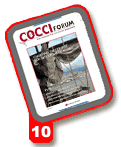
Other articles
in this issue
COCCI Profile: Sensitivity Training
European study backs earlier work in US showing that coccidiosis vaccination restores Eimeria sensitivity.

Landman and Peek: ‘Resistance is a problem of increasing importance.’
|
Coccidiosis vaccination appears
to restore the sensitivity of
European coccidial field isolates
to commercial in-feed anticoccidials,
according to the results of a study
conducted by a leading animal health
institute.
“For poultry producers, restoration
of sensitivity would enable better, more
efficient use of anticoccidial drugs and
improved coccidiosis control,” says Dr.
W.J. Landman, an investigator in the
study, conducted by the Animal Health
Service Ltd. Poultry Health Centre, the
Netherlands, one of the largest and best
equipped animal diagnostic laboratories
in the world.
In-feed anticoccidials have long
been the primary method of controlling
Eimeria, the protozoan coccidial parasite
that causes coccidiosis in poultry,
but widespread resistance to the drugs
has developed after continuous usage,
say Landman and his associate in the
study, H.W. Peek.
The investigators have researched
the sensitivity of coccidia in poultry
since the late 1980s. In 2003, they published
the results of an extensive survey
with coccidial isolates harvested in the
Netherlands from 1996 to 2001 and
reported extensive resistance to commercial
anticoccidials. A paper published
in 2004 showed similar resultsfor isolates taken from Spain and
Germany. Other researchers have also
documented anticoccidial resistance,
Landman says.
Resistance impedes efficient coccidiosis control
“Resistance is a problem of increasing
importance that is impeding the efficient
prevention of coccidiosis,”
Landman and Peek say.
Because anticoccidial resistance can
affect flocks gradually, some poultry
producers are not aware of the problem
or that flock performance is not as
good as it could be; others live with the
reduced performance caused by coccidiosis,
Landman says. “Sometimes,
the resistance is not absolute and the
infection is tempered, but it’s there,” he
adds.

Table 1. Sensitivity findings of three Eimeria species to diclazuril and monensin.
|
In the United States, it is well documented
that coccidial sensitivity to anticoccidial
drugs can be restored with
the use of coccidiosis vaccination,
which replaces wild field strains with
drug-sensitive strains. In Europe, however,
the recent study by Landman and
Peek is believed to be the first of its
kind to show that vaccination can
restore anticoccidial sensitivity in the
field.
In their most recent study, they
determined anticoccidial drug sensitivity
for 21 Eimeria field isolates originating
from broiler farms in Denmark,
Germany, Great Britain, Greece, Italy,
Portugal and Romania. The isolates
were supplied by Schering-Plough
Animal Health Corporation. The in-feed
anticoccidials tested were diclazuril
(Clinacox) and monensin (Elancoban).
There were four groups of nine
chicks that each received the following:
- Group 1: Infected, received diclazuril
at a dose of 1 mg/kg in feed
- Group 2: Infected, received monensin
at a dose of 100 mg/kg in feed
- Group 3: Infected but not treated
with anticoccidials (positive control)
- Group 4: Not infected and not treated
(negative control)
At 8 days of age, the investigators
exposed the first three groups to a
defined number of sporulated oocysts
(oocysts capable of releasing viable
spores) prepared from the Eimeria field
isolates. The isolates in the study were
E. acervulina, E. tenella and E. maxima,
which are all known to cause clinical
coccidiosis in chickens.
The two treated groups started on
medicated feed 2 days before the challenge
and continued until the end of
the experiment. The researchers conducted
a chemical analysis of the anticoccidial
products in the feed to assure
that product concentrations were close
to the desired dose.
At 14 days of age, or 6 days after the
challenge, they necropsied five birds
from Groups 1, 2 and 3 to determine
individual coccidial lesion scores. They
also counted per gram the number of
oocysts in fresh feces, weighed birds
periodically and observed them
throughout the study.
Anticoccidial sensitivity profile

Table 2. More Eimeria isolates were sensitive to anticoccidials that were from vaccinated flocks.
|
The anticoccidial sensitivity profile for
each Eimeria isolate was based on the
percentage reduction of the median
lesion score for each Eimeria type as
compared to the infected, treated
group (Group 3). A reduction of 0% to
30% indicated coccidial resistance, 31%
to 49% indicated reduced sensitivity or
partial resistance and 50% or more indicated
full sensitivity to the anticoccidial,
the investigators say.
There was significant resistance to
both anticoccidials (Table 1), especially
E. acervulina. Of these isolates, 70%
were resistance to diclazuril and 55%
were resistance to monensin, say
Landman and Peek.
“The findings of this study show
that resistance is still widespread
among European coccidiosis field isolates,”
the investigators conclude.
Role of vaccination
The investigators also discovered that
vaccination appeared to affect sensitivity.
“Furthermore, our findings suggest
that
sensitivity toward both anticoccidial
drugs tested occurs more frequently
in Eimeria spp. field isolates
originating from broiler farms where a
coccidiosis vaccination policy is followed,”
they say.
Table 2 summarizes the Eimeria
species that were sensitive to diclazuril
or monensin and the number of them
that came from farms that had or had
not vaccinated.
Landman and Peek are further
studying the effects of vaccination on
Eimeria sensitivity with larger numbers
of birds. It is always possible that the
findings might change, says Landman,
but the results of the just completed
study “very strongly suggest” that
vaccination does, indeed, restore
Eimeria sensitivity to both anticoccidials
tested.
Source: CocciForum Issue No.10, Schering-Plough Animal Health.







 © 2000 - 2021. Global Ag MediaNinguna parte de este sitio puede ser reproducida sin previa autorización.
© 2000 - 2021. Global Ag MediaNinguna parte de este sitio puede ser reproducida sin previa autorización.